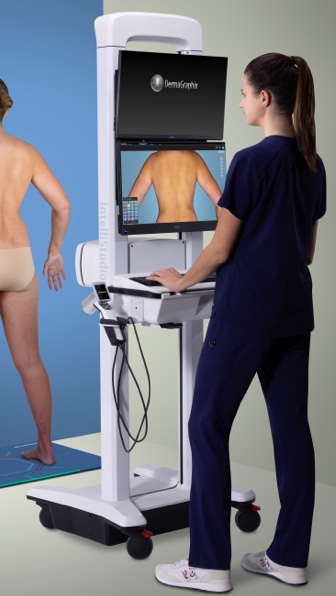Total Body Photography
Total Body Photography is a very useful tool for early detection of melanoma in high risk individuals. If detected early enough, melanoma is 100% curable. Once a melanoma has spread to other parts of the body the cure rate falls to below 50%.
Total Body Photography overcomes many of the limitations of current melanoma surveillance systems. It improves the ability to diagnose melanoma early and reduces the number of unnecessary excisions performed.
How does it work?
Total Body Photography is performed with a machine called IntelliStudio. This machine uses software program called Dermagraphix which controls the camera settings and patient positioning. This allows the IntelliStudio to automatically capture consistent photos of a patient's entire body. In addition, photos of individual moles can be taken with the IntelliStudio to allow careful monitoring. The IntelliStudio represents the latest advance in Total Body Photography systems and also incorporates AI to assist in the identification and diagnosis of melanoma.
Who would benefit from Total Body Photography?
Total Body Photography is recommended for people at increased risk of melanoma. This includes:
-
People who have a personal history of melanoma
-
People with a family history of melanoma in a first degree relative (parent, sibling or child) before the age of 50.
-
People who have many moles (generally over 100)
-
People with more than one large (over 5mm), irregularly shaped or coloured mole. This type of mole is referred to as a dysplastic naevus.
-
Patients with fair skin that tans poorly or with significantly sun damaged skin.
During your initial skin examination Dr Wassall will advise if he feels you would benefit from this procedure.
How often is it performed?
In high risk individuals with lots of moles it is best to perform Total Body Photography every year. The patient will return two weeks prior to their usual skin check to have Total Body Photographs taken. These are then compared with the previous images to look for new or changing lesions which can then be assessed carefully during your skin check.
For people at lower risk it is generally recommended to have Total Body Photography every 5 years or so. When you return for your skin check the photographs form part of your medical record. If a lesion of concern is identified during your examination then the relevant photo is accessed to assess if it has changed or is new. This can be a sign of early melanoma. Conversely, if the lesion looks stable then it is more likely to be benign.
Fees
$150 per Total Body Procedure. There is no Medicare rebate for this procedure. Some Private Health Funds may provide partial reimbursement but it is the patient's responsibility to investigate this.



